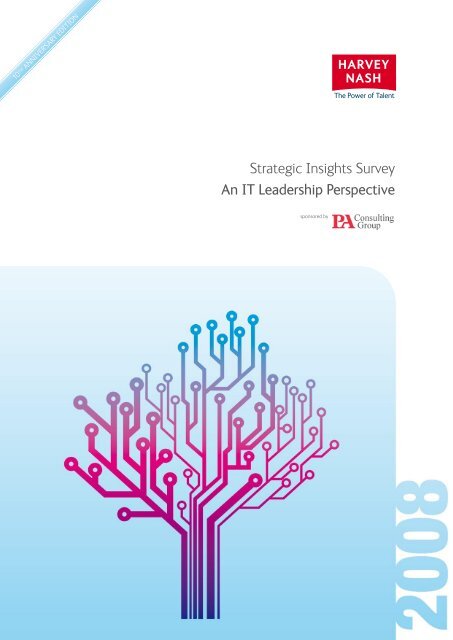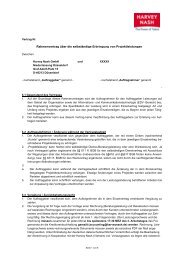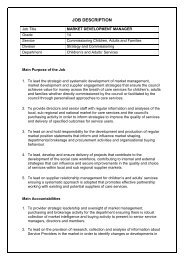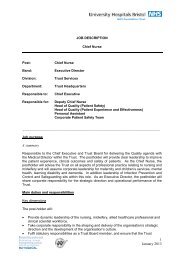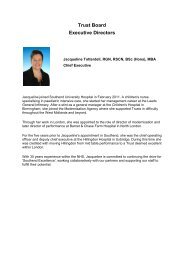Strategic Insights Survey An IT Leadership Perspective - Harvey Nash
Strategic Insights Survey An IT Leadership Perspective - Harvey Nash
Strategic Insights Survey An IT Leadership Perspective - Harvey Nash
Create successful ePaper yourself
Turn your PDF publications into a flip-book with our unique Google optimized e-Paper software.
10 th <strong>An</strong>niversary Edition<strong>Strategic</strong> <strong>Insights</strong> <strong>Survey</strong><strong>An</strong> <strong>IT</strong> <strong>Leadership</strong> <strong>Perspective</strong>sponsored by
Contents1. Foreword 32. Executive summary 43. CIO Forum 84. <strong>Survey</strong> results 134.1 Participants’ profile 144.1.1 Respondents 144.1.2 Titles 144.1.3 Reporting Lines 144.1.4 Board Membership 154.2 Responsibilities 164.2.1 <strong>IT</strong> Budget 164.2.2 <strong>Strategic</strong> Responsibility 164.2.3 Geographic Responsibility 174.2.4 Key Business Issues 184.2.5 <strong>IT</strong> Integration 184.2.6 Revenue Generation 194.3 Skill sets 204.3.1 Industry Skills Shortage 204.3.2 <strong>IT</strong> Leader Skills 204.3.3 Staff Skills 214.3.4 Migrating Skills 224.4 Innovation 234.4.1 Innovation for Competitive Advantage 234.4.2 Innovation Collaboration 244.4.3 Innovation Investment 254.5 <strong>IT</strong> Projects 274.5.1 Completed Projects 274.5.2 Challenges 284.6 Outsourcing and Offshoring 304.6.1 Outsourcing 304.6.2 Outsourcing Spending 314.6.3 Outsourcing Reasons and Functions 314.6.4 Activities Outsourced 324.6.5 Offshoring 324.7 Employment and Career 344.7.1 Length of Time with Current Employer 344.7.2 Likely Length of Continuing with Employer 344.7.3 Level of Fulfillment 354.7.4 Job Search Activity 354.7.5 Deciding Factor in Changing Jobs 364.8 Compensation 374.8.1 Base Salary 374.8.2 Benefits 374.8.3 Compensation Satisfaction 385. Comment and conclusions 392008 <strong>Strategic</strong> <strong>Insights</strong> <strong>Survey</strong> - <strong>An</strong> <strong>IT</strong> <strong>Leadership</strong> <strong>Perspective</strong>
1. ForewordWelcome to the 2008 <strong>IT</strong> <strong>Leadership</strong> <strong>Survey</strong>This year we mark a significant milestone, our 10th year publishingthe <strong>IT</strong> <strong>Leadership</strong> survey. Since its introduction in 1998 it hasprovided an objective analysis of the goals and issues confrontingtoday’s <strong>IT</strong> leaders, firmly establishing itself as the industry benchmarkover the past decade.The survey was made possible by more than 350 respondents whocontributed their insight and vision. I would like to thank each of them for taking thetime to scrutinise the <strong>IT</strong> industry so that <strong>Harvey</strong> <strong>Nash</strong>, our partner PA Consulting and ourclients can better understand what today’s <strong>IT</strong> leader is facing.This year we have canvassed a wide selection of leaders, from within the <strong>IT</strong> function andbeyond. Contribution has been received from CEOs, COOs, CFOs, CIOs as well as a rangeof people from the technology industry.The report indicates that the role of the <strong>IT</strong> leader, like technology itself, is constantlychanging and evolving. The relentless pursuit for operational efficiencies and competitiveadvantages continues unabated, but the priorities of each change with the times.Our thanks go again to PA Consulting, our partners in the <strong>IT</strong> <strong>Leadership</strong> survey forthe past two years, who have contributed significant insight in the sourcing strategy,innovation and <strong>IT</strong> project success sections of the report.It is our hope that you find this survey both informative and enlightening. It is said thathistory repeats itself. With the help of our respondents and partner PA Consulting, let’slearn what history <strong>IT</strong> is teaching us so we can look forward with confidence.Albert EllisChief Executive<strong>Harvey</strong> <strong>Nash</strong>2008 <strong>Strategic</strong> <strong>Insights</strong> <strong>Survey</strong> - <strong>An</strong> <strong>IT</strong> <strong>Leadership</strong> <strong>Perspective</strong>
2. Executive summaryIs Collaboration the Key?This report has, over the last three years, witnessed the erosion of influence <strong>IT</strong> leaderswield in shaping business strategy. Yet <strong>IT</strong> leaders desire to be business leaders, to havethat strategic influence, and their aspirations have driven <strong>IT</strong> in new and innovative ways.As darkening economic clouds have loomed and with little budget allocated forinnovation, <strong>IT</strong> leaders are collaborating with suppliers and customers to help driveefficiency and create new revenue streams. Going forward, and for the same reasons,collaborating on innovation could be the key to success for many firms as competitiveand economic pressures mount.It is anticipated that with increased collaboration on innovation projects, <strong>IT</strong> leaderswill be able to grow their strategic influence with the CEO and main Board. <strong>An</strong>d havingdelivered measurable results when times are tough, we expect them to be rewardedwith the strategic influence they desire.<strong>Strategic</strong> InfluenceThe reality, however, is that the role of the <strong>IT</strong> leader, while still strategic in nature,is becoming less so year-over-year. Two years ago 76 per cent thought the role wasbecoming more strategic. This year it has slipped to 57 per cent. It should be notedthat at the very top level, CIOs at the largest firms are getting more involved in businessstrategy. However, <strong>IT</strong> leaders at the second and third tier appear disenfranchised anddrifting away from the business. Nearly a quarter of the respondents, 21 per cent,have no input whatsoever into the shaping of the business strategy, but rather has thestrategy dictated to them by the Board. <strong>An</strong>d with regard to the Board, less than half ofthe respondents (44 per cent) are members.But one of the more telltale signs is that the most important key business issue the Boardlooks to technology to address is enhancing operational efficiency. This supersedesstrategic initiatives such as developing new products, entry to new markets, innovationand improving price competitiveness. For 17 per cent of the businesses, <strong>IT</strong> is not evenexpected to innovate with technology to improve competitive advantage. For 55 percent of the businesses that do have an expectation of innovation, no targets have evenbeen set.<strong>Leadership</strong>Today’s CIO not only desires to be a business leader, they need to be. Almost threequartersof the respondents, 73 per cent, thought that the CIO should be on the mainBoard. The top two skills considered essential for a CIO to advance to the main Board aresoft skills more commonly associated with business management capabilities, those ofleadership and communication. These are the identical top two skills that respondentsconsidered essential in their own roles. What is interesting is that the need for in-depth<strong>IT</strong> awareness, the knowledge base over which they preside, ranked outside the top 10and was second to last on both accounts.2008 <strong>Strategic</strong> <strong>Insights</strong> <strong>Survey</strong> - <strong>An</strong> <strong>IT</strong> <strong>Leadership</strong> <strong>Perspective</strong>
2. Executive summary...So clearly the ability to lead trumps the ability to be technical, and it was further apparentwhen considering their role. For example, with over half the respondents admitting tosome form of project failure in the last 12 months, technology shortfalls cannot beblamed for all the problems. To some extent, projects are still failing because of poorleadership and weak governance.The Movement of Top TalentThe changing role of <strong>IT</strong> leaders, evolving into something more suggestive of a supportfunction, is counter to their desire to be strategic business leaders and is ultimatelyinfluencing churn in the employment markets.Those that find their role either fulfilling or very fulfilling has steadily declined from 84per cent in 2006 to 74 per cent this year. Likewise, those that find their role not veryfulfilling or not at all fulfilling increased correspondingly from 17 per cent in 2006 to 25per cent this year. The key to fulfillment for them can be found in the top two decisionmaking factors the respondents would look for if moving to a new organisation, thoseof having a greater involvement in business strategy and a fresh challenge. Combined,63 per cent said these were their hot buttons.Even more telling is that only seven per cent of respondents would not consider a newjob elsewhere, whereas 72 per cent are already looking for a new job or would entertaina call from a head hunter. In the next two years 63 per cent of the technology leadersexpect to no longer be with their current employer but will have moved jobs, up fiveper cent from last year. <strong>An</strong>d all of this comes at a time when those either satisfied orextremely satisfied with their remuneration package is up eight per cent from last year,to 79 per cent this year.It’s a cause and effect relationship. The decline in influence is related to the decline injob fulfillment and ultimately the rise in defection.The Dominance of OutsourcingOutsourcing and off shoring are not only here to stay they are becoming an even greaterpart of the <strong>IT</strong> fabric. Spending on outsourcing is expected to increase for 53 per centof the respondents and off shoring to increase for 41 per cent of the respondents inthe next 12 months. However, there is a disconnect between this expected increasein spend and the fact that 44 per cent of organisations do not have a documentedsourcing strategy and in the case where a sourcing strategy exists, only 43 per cent arereviewed at board level.2008 <strong>Strategic</strong> <strong>Insights</strong> <strong>Survey</strong> - <strong>An</strong> <strong>IT</strong> <strong>Leadership</strong> <strong>Perspective</strong>
2. Executive summary...The <strong>IT</strong> of YesterdayThe decline in strategic focus for <strong>IT</strong> departments may be a product of past performanceissues and lingering perceptions. Over one quarter of the respondents believe the <strong>IT</strong>systems within the business are not seen as a value added component to the budget.This is not an encouraging viewpoint. Even among technology leaders themselves, 54per cent don’t feel that that the <strong>IT</strong> function is an effective means for increasing overallbusiness revenue.But assessments like these are often born from experience. The continuing goal of <strong>IT</strong>leaders and their organisations to integrate <strong>IT</strong> into the business has been accomplishedat an advanced or full level for 57 per cent of the respondents, yet 42 per cent ofthe businesses remain integrated at only a limited level or not at all. Even shorterterm initiatives are subject to questionable measurements of success. <strong>IT</strong> projects, forexample, have failed or been cancelled for 63 per cent of the respondents.<strong>An</strong>d so, when business planning is conducted, the role <strong>IT</strong> will undertake is influenced bythe confidence that it can deliver predictable and measurable results.What Technology Skills Shortage?While nearly three-quarters said their business suffers from a skills shortage, it is thetype of skills that are in question. Today’s <strong>IT</strong> leaders recognise the importance of, andneed for, more than just technology skills, but also business skills within their own team.The principal skill considered most important for the technology team was building andmaintaining relationships with business.Keeping with business, the top talent development priority of technology leaders to upskilltheir workforce in the next year are management development programs. This waseven ranked ahead of technology training. It is apparent that the ideal <strong>IT</strong> member musthave both technology and business acumen.Bring on the InnovationInnovation is critically important to the business, and <strong>IT</strong> has been rather successful inits effectiveness to deliver that innovation. The overwhelming majority of businesses,83 per cent, look to <strong>IT</strong> to innovate with technology to improve competitive advantage,and <strong>IT</strong> has responded.<strong>IT</strong> has generated technology ideas either occasionally or frequently for 90 per centof the respondents, and more importantly the innovation has been either reasonablyor very successful 80 per cent of the time. In fact, innovation has yielded a return oninvestment of five per cent or more for 55 per cent of the respondents.Innovation collaboration seems to be happening more and more frequently and themore you collaborate the better your results. Those who are successful at innovationand get the highest returns do more collaborating than average.2008 <strong>Strategic</strong> <strong>Insights</strong> <strong>Survey</strong> - <strong>An</strong> <strong>IT</strong> <strong>Leadership</strong> <strong>Perspective</strong>
2. Executive summary...Two thirds of respondents will collaborate with their suppliers. This is probablyunsurprising given that suppliers have the greatest incentive of all groups for sharingtheir technology with their customers. However, it is also worth noting that successfulcompanies are more likely to collaborate with their customers and professional servicesfirms. Additionally, successful companies are also twice as likely as average to collaboratewith competitors.Expand Your HorizonsThe next great technology idea doesn’t have to come entirely from within. The successof innovation efforts has not relied solely on organic ideas, but rather has appropriatedhelp from <strong>IT</strong> suppliers, customers, industry peers and even competitors.2008 <strong>Strategic</strong> <strong>Insights</strong> <strong>Survey</strong> - <strong>An</strong> <strong>IT</strong> <strong>Leadership</strong> <strong>Perspective</strong>
3. CIO ForumWelcome to the CIO Forum, a new addition to the <strong>Harvey</strong> <strong>Nash</strong> <strong>IT</strong><strong>Leadership</strong> Report.This overview is a first step in developing the forum, which we hope will evolve into avirtual meeting-place for great ideas, advice and analysis for CIOs everywhere. Thoseof you who contributed to our survey will be the first to be informed of our web basedCIO forum.In early April at Hibiscus, the Michelin stared restaurant operated by Claude and ClaireBosi in Mayfair, London, an exclusive group of CIOs joined <strong>Harvey</strong> <strong>Nash</strong> to discuss someof the challenges and opportunities they expected to face in 2008/09.<strong>Harvey</strong> <strong>Nash</strong> Chief Executive, Albert Ellis, hosted the event, which was facilitated byBryan MacDonald, Director of our CIO practice. Below is a profile of our inaugural CIOForum attendees with an overview of the discussion provided on the following pages.The CIO Forum attendeesDavid Boulter, CEO, Cap Gemini AspireCurrently Chief Executive of Cap Gemini ASPIRE (the outsourced technology providerfor HM Revenue & Customs), David has previously worked for BP plc in various groupexecutive roles including technology, commercial, strategic planning and exploration.Peter Brickley, CEO, Ashcombe PartnershipPeter has spent his career representing the <strong>IT</strong> function, as CIO of British AmericanTobacco and Centrica. He is especially experienced in driving transformation withinbusinesses, resolving material commercial conflict and driving <strong>IT</strong> as a commercialbusiness unit.Trevor Didcock, CIO, HomeservePreviously Information Systems Director of The AA, Trevor was a member of theexecutive management team responsible for the well-publicised private equity backeddevelopment of the AA. Profit increased from £93m in 2003 to £280m in 2007.Fabian Di Felice, Head of <strong>Strategic</strong> Business Systems, British American TobaccoFabian has built his career in a range of industries and has served global firms includingUnilever. At British American Tobacco, he was <strong>IT</strong> Director for Central Europe for a numberof years before being appointed to a global role as Head of <strong>Strategic</strong> Business Systems.Lars e Hjaltman, CIO at Group RCILars has led organisations of up to 2,500 staff, has been responsible for a divisional $400mbudget and outsourcing contracts with large offshoring elements of up to $700m. Hecurrently leads the <strong>IT</strong>/IS function at Group RCI through a period of transformation andchange.2008 <strong>Strategic</strong> <strong>Insights</strong> <strong>Survey</strong> - <strong>An</strong> <strong>IT</strong> <strong>Leadership</strong> <strong>Perspective</strong>
3. CIO ForumMyron Hrycyk, CIO, Severn TrentMyron has spent his career re-organising corporate <strong>IT</strong> units and deploying highperformance <strong>IT</strong> practices for international businesses operating within a number ofdifferent sectors.Gordon Lovell-Read, CIO, SiemensHired by Siemens in 2002 after impressing the company's CFO on an <strong>IT</strong> project he wasworking on for them while at previous employer Hewlett-Packard. Gordon became CIOand is the only member of the executive management board to have been appointedfrom outside the company.Jonathan Merry, Business Technology Director, PfizerJonathan joined Pfizer as Business Technology Director in August 2006. He previouslyworked as Business Systems and e-Business Director at Coca-Cola Enterprises. Sincejoining Pfizer, Jonathan has driven a step change in <strong>IT</strong> by leading the development of<strong>IT</strong> strategy and governance.Mayank Prakash, CIO, SageMayank is a member of the senior management team at Sage, an organisation that nowemploys over 13,000 people in its market leading companies worldwide. In the UK, Sageemploys over 1600 people and provides software and services to 700,000 small andmedium sized businesses.Kevin Rodgers, <strong>IT</strong> Director, Interserve Facilities ServicesAt Interserve Kevin is responsible for creating a centralised <strong>IT</strong> function and effectivelyintegrating it with the business. Kevin took control of three entirely different <strong>IT</strong>departments and merged them, selecting personnel, technologies and processes.John Sillitoe, Director ICT at Serco SolutionsJohn is responsible for the delivery of all systems and infrastructure across Serco UK.His role covers a wide range of applications for central and local government andincludes a support organisation that handles over 750,000 incidents per year. John isalso accountable for all offshore delivery.Nigel Underwood, CIO, DHLNigel became Chief Information Officer of DHL Logistics in December 2005, havingpreviously been a member of the Executive Board and CIO at Exel since 2001. ANottingham University graduate, Nigel's early career was spent with fast-movingconsumer goods companies Boots, Mars and Coco-Cola Schweppes. Prior to joiningExel, Nigel was Senior Vice President, <strong>IT</strong> for the Hilton Group.2008 <strong>Strategic</strong> <strong>Insights</strong> <strong>Survey</strong> - <strong>An</strong> <strong>IT</strong> <strong>Leadership</strong> <strong>Perspective</strong>
3. CIO Forumthe best leaders in <strong>IT</strong> were those who excelled in generalmanagement as well as having a strong record of technical successThe Forum produced some fascinating insights, which we are delighted to share withyou here.CIOs on leadershipFabian Di Falice of British American Tobacco (BAT) was a prominent member of theforum who believed that the best leaders in <strong>IT</strong> were those who excelled in generalmanagement as well as having a strong record of technical success. Lars Hjaltman ofRCI strongly agreed and said he was concerned about the lack of leadership skills inthe <strong>IT</strong> function. He felt the bias in people development still leaned towards developingfunctional skills.There was a consensus amongst forum attendees that aspiring CIOs need supportthroughout their career to develop the diverse skills needed by a modern <strong>IT</strong> leader.Jonathan Merry of Pfizer observed that the standard career path in <strong>IT</strong> has radicallychanged in recent years. No longer is it sufficient to learn functional skills – beingpolitically savvy and commercially astute is now high on the agenda. Additionally,knowing how to influence and negotiate with demanding business owners around thedeployment of resources in favour of new and emerging markets was a critical ability.Mayank Prakash from Sage argued that the modern CIO needed to be a leader whocould comfortably manage cross-functional businesses. Managing upwards is equallyimportant for developing a strong leadership profile, according to the forum. GordonLovell-Reed of Siemens impressed upon the group that understanding the responsibilitiesand drivers of the Board was crucial in knowing how to influence the Board agenda– finding the right angle with the right people is key.Creating an environment for successNigel Underwood from DHL hinted that success is only really achieved in thoseorganisations where a portfolio of values is based on credibility and trust, as well asconsistency in processes and behaviours. He saw talent management and getting theright team dynamic as one of the CIOs biggest challenges but the also the strongestfoundation for success.Mayank Prakash felt that time spent coaching and leading people from other parts of thebusiness, as he has done at Sage, benefits everyone involved. This view was echoed byother members of the forum who suggested that technology itself is not a competitiveadvantage these days (most of us have the same technology in our firms) but aligningand synchronising people, processes and technology is a key differentiator.102008 <strong>Strategic</strong> <strong>Insights</strong> <strong>Survey</strong> - <strong>An</strong> <strong>IT</strong> <strong>Leadership</strong> <strong>Perspective</strong>
3. CIO Forumtalent management and getting the right teamdynamic is one of the CIOs biggest challengesJohn Sillitoe summarised the “Head, Heart, Hands” approach that Serco has brought toskills development for senior managers has enabled them to drive change throughoutthe business. David Boulter of CapGemini Aspire felt that it was as much the responsibilityof the CIO as the Marketing or Sales Director to ensure the business was targeted at the“premium market” and was differentiated from the commodity providers.Next generation talentStan <strong>An</strong>derson of <strong>Harvey</strong> <strong>Nash</strong> said he was gripped and amazed by the mobility of thenew generation of talent – he said young people are far likelier to opt for internationalassignments in their careers and should be encouraged to do so.Peter Brickley of Aschcombe agreed that developing the next generation of leadersis essential but warned that as a CIO you can only really be successful when you trackwhere the pulse of the organisation is. Changing the way business is done to satisfy anew generation is important for retention, but should only be adopted when it addsvalue to the business as a whole.Myron Hrycyk of Severn Trent asked the forum how good they could honestly say theywere as mentors and coaches. While he accepted that everyone round the table wasprobably comfortable in a customer centric role, selling and providing solutions tocustomers, it was also their responsibility to grow these skills throughout their business,particularly with their successors.It was clear to the group that succession planning was the key to long-term success,that grooming your eventual replacement is essential as well as being clear on the skillsyour successor will need.CIO opportunities and challengesThere are many economic and technical factors currently influencing the modernCIO. According to Di Falice one of the most prominent that BAT face is addressing theinformation agenda of the 21st century. As BAT continues to grow internationally thereis an ever-increasing pressure to help the organisation with the information it needs torun on a global basis.John Sillitoe admits that Serco is grappling with getting the right balance betweenempowering employees to innovate and collaborate, with the security issues suchfreedom brings. While Trevor Didcock of Homeserve agreed with many of the pointsaround providing flexible and creative working opportunities, he asked the forum not tooverlook the 'real world' responsibility of <strong>IT</strong> to reduce complexity and cost.2008 <strong>Strategic</strong> <strong>Insights</strong> <strong>Survey</strong> - <strong>An</strong> <strong>IT</strong> <strong>Leadership</strong> <strong>Perspective</strong> 11
3. CIO Forumwhile the “Green Agenda” is always a great topic to bring up atBoard meetings it still lacks the credibility within most organisationsAs the forum drew to a close David Boulter of CapGemini Aspire asked people to thinkabout the issues that are not yet seen as mainstream. He said that Boards are constantlybecoming younger, and much more process and technology savvy – they want to knowhow they differentiate their business in a fast moving world. Fabian Di Falice (BAT)agreed and spoke about his view of Vietnam as the hub to South East Asia, especiallyconsidering the Vietnamese population has 35 million people under the age of 30!Gordon Lovell-Reed concluded that while the “Green Agenda” is always a great topic tobring up at Board meetings it still lacks the credibility within most organisations as a costsaving tool or strategy differentiator.Thank youWe hope you have enjoyed this brief insight into our CIO Forum. We are extremelygrateful to our CIO participants and look forward to welcoming our CIO audience tomore forum events in the future.Best RegardsBryan MacDonalddirectorharvey <strong>Nash</strong> CIO Practicewww.harveynash.com/cio122008 <strong>Strategic</strong> <strong>Insights</strong> <strong>Survey</strong> - <strong>An</strong> <strong>IT</strong> <strong>Leadership</strong> <strong>Perspective</strong>
4. <strong>Survey</strong> Results2008 <strong>Strategic</strong> <strong>Insights</strong> <strong>Survey</strong> - <strong>An</strong> <strong>IT</strong> <strong>Leadership</strong> <strong>Perspective</strong> 13
4.1 Respondents' profilethe importance placed on <strong>IT</strong> and its influencewithin the organisation has been steadily eroding4.1.1 RespondentsThe number of respondents to this year’s survey exceeded 360 individuals. Therespondents come from a wide range of industry sectors, with the largest group (22 percent) working in the <strong>IT</strong> industry itself. The next largest groups were financial servicesand business services with 12 per cent and seven per cent respectively.25%Figure 1. Top 10 industry sectors22%20%15%12%10%9%7%6% 6%5%4% 4%3% 3%0%InformationtechnologyFinancial servicesManufacturingBusiness servicesLocal, regional andnational governmentRetailConstructionFood and drinkBroadcast, film andinteractive mediaEducation4.1.2 TitlesThe largest group, those that are CIO/CTOs, represented 31 per cent of the respondents.Senior <strong>IT</strong> managers accounted for 23 per cent, and other C-level titles (CEO, CFO, etc.)another 21 per cent. The remainder consisted primarily of other senior management ormid-level <strong>IT</strong> managers.4.1.3 Reporting LinesThose reporting directly to the CEO constituted 36 per cent of the respondents, withinone per cent of last year’s survey. Following the CEO, the Finance Director/CFO was thenext most reported to at 13 per cent and then the Operations Director/COO at 12 percent.While in line with last year’s and the prior year’s results, there nonetheless has been asteady decline in those reporting to the CEO over the last seven years. Shown graphicallyin the chart below, this decline suggests that the importance placed on <strong>IT</strong> and itsinfluence within the organisation has been steadily eroding.142008 <strong>Strategic</strong> <strong>Insights</strong> <strong>Survey</strong> - <strong>An</strong> <strong>IT</strong> <strong>Leadership</strong> <strong>Perspective</strong>
4.1 Respondents' profile46 per cent of respondents are a member of the operational BoardFigure 2. Percentage of technology leaders reporting to the CEO over time60%58%50%51%49%45%40%36%35%36%30%20%10%0%20022003200420052006200720084.1.4 Board MembershipThis year’s survey results were identical to last year’s with 54 per cent not a member ofthe operational Board and correspondingly 46 per cent were.Figure 3. Are you a member of the operational Board?54%46%yesno2008 <strong>Strategic</strong> <strong>Insights</strong> <strong>Survey</strong> - <strong>An</strong> <strong>IT</strong> <strong>Leadership</strong> <strong>Perspective</strong> 15
1.00.80.60.40.20.04.2 ResponsibilitiesFive per cent (of respondents) had an <strong>IT</strong> budget of over £250m4.2.1 <strong>IT</strong> BudgetThe median <strong>IT</strong> budget for those surveyed was in the range of £1M-£10M, although fiveper cent had <strong>IT</strong> budgets of over £250M. Over the last year 37 per cent reported havingan increased budget while 17 per cent had a budget decrease. The remainder, 46 percent, had no budget change.Figure 4. Change in <strong>IT</strong> budget in the last year17%46%Stayed the sameIncreasedDecreased37%4.2.2 <strong>Strategic</strong> ResponsibilityWhile the majority of respondents still feel that the role of the CIO is becoming morestrategic within their organisation, the number has actually steadily declined from 76per cent in 2006, to 62 per cent last year to 57 per cent this year. Similarly, those thatfelt the role of the CIO was becoming less strategic increased from six per cent to 14 percent over the same time period. The chart that follows shows this erosion of strategicresponsibility.Figure 5. Percentage who believe the role of CIO is becoming more strategic80%76%70%62%60%57%50%40%30%20%10%0%200620072008162008 <strong>Strategic</strong> <strong>Insights</strong> <strong>Survey</strong> - <strong>An</strong> <strong>IT</strong> <strong>Leadership</strong> <strong>Perspective</strong>
4.2 Responsibilities62 per cent have responsibilities thatextend beyond the borders of the UKHaving strategic responsibility would seemingly imply that one would have influence inshaping business strategy, yet nearly one-quarter (21 per cent) have no input into thatstrategy. Rather, their strategy is dictated to them by the Board.Figure 6. How much influence do you have in shaping business strategy?4%21%41%34%I am a member of the Board who develops thestrategy and communicates this to the businessI am a senior member of management who workswith the Board to develop the strategyI am a member of the senior management team andour strategy is communicated to us by the BoardOtherThe <strong>IT</strong> leaders themselves clearly desire a strategic role and to be thought of andacknowledged as a business leader. Almost three-quarters of the respondents, 73 percent, thought that the <strong>IT</strong> director should be on the main Board.Figure 7. Should the <strong>IT</strong> director be on the main Board?27%yesno73%4.2.3 Geographic ResponsibilityThe globalisation of business is evident. Of the respondents, 62 per cent haveresponsibilities that extend beyond the borders of the UK. In fact, 37 per cent haveresponsibilities that are global in nature.2008 <strong>Strategic</strong> <strong>Insights</strong> <strong>Survey</strong> - <strong>An</strong> <strong>IT</strong> <strong>Leadership</strong> <strong>Perspective</strong> 17
4.2 Responsibilities57 per cent, thought <strong>IT</strong> had achieved advanced or full integration with the businessFigure 8. Geographical spread of responsibility6%37%38%UK onlyEuropeGlobalOther19%4.2.4 Key Business IssuesThe single most important key business issue the Board looks to technology to addressis enhancing operational efficiency, as stated by 76 per cent of the respondents. Justover one-half (51 per cent) considered it to be innovation, followed by developing newproducts (41 per cent) and entry to new markets (40 per cent).Figure 9. What are the key issues that your Board is looking for technology to address?Entry to new markets 40%Developing new products 41%Innovation 51%Improving price competitiveness 39%Enhancing operational efficiency 76%Responding to globalisation 23%Other 9%4.2.5 <strong>IT</strong> IntegrationRespondents were nearly evenly split in their opinion of how well integrated the <strong>IT</strong>function is within their business. Just over one-half, 57 per cent, thought <strong>IT</strong> had achievedadvanced or full integration while 43 per cent had limited or no integration. Of real noteis that only 16 per cent believed <strong>IT</strong> to be fully integrated.Figure 10. How integrated is the <strong>IT</strong> function within your business?2%16%Stand alone41%Limited integrationAdvanced integration41%Full integration182008 <strong>Strategic</strong> <strong>Insights</strong> <strong>Survey</strong> - <strong>An</strong> <strong>IT</strong> <strong>Leadership</strong> <strong>Perspective</strong>
4.2 Responsibilities54% do not believe the <strong>IT</strong> function is aneffective means to increase business revenue4.2.6 Revenue GenerationOver one-quarter, 28 per cent, of the respondents believe the <strong>IT</strong> systems within thebusiness are not seen as a value added component to the corporate budget. Thiscertainly is not a strong vote of confidence for <strong>IT</strong>.Figure 11. Are the <strong>IT</strong> systems within the business seen as a value added componentto the budget?28%yesno72%Perhaps more interesting is that among the technology leaders themselves, 54 percent do not believe the <strong>IT</strong> function is an effective means to increase business revenue.Of those that did, the respondents felt that <strong>IT</strong> contributed 40 per cent of the overallbusiness revenue.Figure 12. Is your <strong>IT</strong> function an effective means of increasing overall businessrevenue?54%46%yesno2008 <strong>Strategic</strong> <strong>Insights</strong> <strong>Survey</strong> - <strong>An</strong> <strong>IT</strong> <strong>Leadership</strong> <strong>Perspective</strong> 19
4.3 Skill Sets71 per cent believe their business suffers from a skills shortage4.3.1 Industry Skills ShortageNearly three-quarters of the respondents, 71 per cent, believe that their business suffersfrom a skills shortage.Figure 13. Does your business suffer from a skills shortage?29%yesno71%Although faced with a skills shortage, it is positive to note that only ten per cent believeit will have a significant financial impact on their business. But for the majority, 51 percent, it unfortunately will have at least some impact in slowing growth.Figure 14. What financial impact will this skills shortage have on your business?10% 15%No impact51%24%Minimal impactSome impactSignificant impact4.3.2 <strong>IT</strong> Leader SkillsWhen the respondents were asked how important various skills or attributes were totheir own role as <strong>IT</strong> leader, the top three responses considered essential were all softskills more commonly associated with business and management capabilities – those ofleadership skills, communication skills and influencing skills. The respondents were alsoasked what skills were essential in helping an <strong>IT</strong> director advance to the main Board, andthe top three responses were identical.202008 <strong>Strategic</strong> <strong>Insights</strong> <strong>Survey</strong> - <strong>An</strong> <strong>IT</strong> <strong>Leadership</strong> <strong>Perspective</strong>
4.3 Skill Sets<strong>IT</strong> leaders recognise the need for more than just technology skillsFigure 15. Top three skills for <strong>IT</strong> leaders% saying skill was essentialCommunication skills 74%<strong>Leadership</strong> skills 70%Influencing skills 69%This may not be all that surprising, but what was interesting is that the need for in-depth<strong>IT</strong> skills wasn’t even in the top 10 for either question. In fact, <strong>IT</strong> skills were second fromlast, or 13 out of 14, with only 22 per cent saying it was essential.4.3.3 Staff SkillsWith regard to the skills considered to be very important within their own team, theresponses indicate that <strong>IT</strong> leaders recognise the need for more than just technology skills.The top response, by 68 per cent, was for the team to build and maintain relationshipswith business. This was followed by managing <strong>IT</strong> developments and programs, andmanaging and delivering <strong>IT</strong> operations, both of which were deemed very important by54 per cent.Figure 16. Top three capabilities needed in the team% saying skill wasCapabilityvery importantBuilding and maintaining relationships with the business 68%Managing <strong>IT</strong> developments and programmes 54%Managing and delivering <strong>IT</strong> operations 54%When then asked to rate how effective their team was at these exact same capabilities,the responses indicated a significant shortfall between the importance the <strong>IT</strong> leaderplaced on the attribute and the proportion of staff the leader felt was excellent at it.Figure 17. Capability of team versus desired level of excellence% rated % desiredCapabilityBuilding & maintaining relationships with the businessexcellent10%excellent68%Managing <strong>IT</strong> developments and programmes 18% 54%Managing and delivering <strong>IT</strong> operations 23% 54%The top talent development priority to up-skill their workforce in the coming year forover half of the respondents, 59 per cent, are management training programs. Technicaltraining programs ranked third at 47 per cent.2008 <strong>Strategic</strong> <strong>Insights</strong> <strong>Survey</strong> - <strong>An</strong> <strong>IT</strong> <strong>Leadership</strong> <strong>Perspective</strong> 21
4.3 Skill Sets72 per cent, believe that the migration of skilledprofessionals from Europe and Asia is a positive trendFigure 18. What will be your talent development priority this year to up-skill yourworkforce?% saying priorityInformal development with peers 52%Technical training programmes 47%Management training programmes 59%Communication training programmes 34%Use of Web 2.0 technology to share knowledge 18%Work/release programmes for flexible training 13%Other 7%4.3.4 Migrating SkillsConsidering the skills gap in the UK, nearly three-quarters, 72 per cent, believe that themigration of skilled professionals from Europe and Asia is a positive trend. This is upslightly from the 66 per cent who said the same last year.Figure 19. Do you believe skilled migration from abroad can help fill the UK skills gap?28%yesno72%222008 <strong>Strategic</strong> <strong>Insights</strong> <strong>Survey</strong> - <strong>An</strong> <strong>IT</strong> <strong>Leadership</strong> <strong>Perspective</strong>
4.4 Innovation<strong>IT</strong> has always held the promise of deliveringmore than just a support function4.4.1 Innovation for Competitive Advantage<strong>IT</strong> has always held the promise of delivering more than just a support function, of being abusiness driver, so it is not surprising that the business looks for technology innovationsfrom <strong>IT</strong> to improve its competitive advantage.In last year’s survey, we looked at <strong>IT</strong> innovation and the role it had to play as a driver forbusiness growth and value creation. We found that there was a clear business demandfor <strong>IT</strong> to innovate, that the most successful organisations were more likely to set targetsand innovate frequently, but for a majority of organisations there was no structuredapproach and results were disappointing.This year we wanted to confirm our results from last year (and compare any trends), butalso to dig below the surface to find out and share how the most successful organisationswent about their innovation activities.We asked questions about the techniques people used to innovate, the percentage oftheir <strong>IT</strong> budget they invested in innovation activities, and the typical returns they got.We then analysed the results comparing the main group of respondents against thoseclaiming high levels of success or more than 10 per cent ROI to determine the key tosuccess.There is still high demand for <strong>IT</strong> innovation from business unitsThere is still high business demand from business users for innovation from <strong>IT</strong>. Thisyear 83 per cent of <strong>IT</strong> leaders said their business colleagues expected them to deliverinnovation compared with 84 per cent last year. However, the frequency of innovationand relative success has not improved. This year 21 per cent of <strong>IT</strong> leaders claimed to bevery successful, compared with 22 per cent last year. The percentage of those claimingto innovate frequently (a key indicator of success) has actually dropped from 32 percent to 25 per cent. So what techniques are used to innovate? What sort of results dopeople get? How do the successful organisations do it?Figure 20. Does your business look to <strong>IT</strong> to innovate with technology to improvecompetitive advantage?2%15%28%Yes, targets reflect the need to innovateYes, but no targets are setNo, innovation expected only in business unitsNo, other55%2008 <strong>Strategic</strong> <strong>Insights</strong> <strong>Survey</strong> - <strong>An</strong> <strong>IT</strong> <strong>Leadership</strong> <strong>Perspective</strong> 23
4.4 Innovationit is difficult to innovate in isolationGenerating technology ideas to improve competitive advantage has been accomplishedeither occasionally or frequently by 90 per cent of the businesses. Only 10 per cent havenever generated an idea or accomplished it just once.Figure 21. Frequency of technology innovations to improve competitive advantage6%4%25%NeverOnceOccasionallyFrequently65%4.4.2. Innovation CollaborationIt is generally regarded that it is difficult to innovate in isolation – the best resultsare achieved by collaborating with other parties. So, have our <strong>IT</strong> innovators beencollaborating, and if so with whom?Across all respondents a range of techniques are used. The top four are presentationsfrom suppliers, defined innovation projects, idea generation sessions with staff andsessions with industry groups and collaborators.Figure 22. Source of collaborationPresentations from <strong>IT</strong> suppliersDefined projects with an innovation focusIdea generation sessions with staffSessions with industry groups and collaboratorsStaff suggestions boxDedicated innovation teamNoneOther4%8%10%9%9%14%13%16%19%21%25%22%44%52%47%56%57%55%57%52%48%49%53%72%> 10% ROISuccessfulAll respondents0% 10% 20% 30% 40% 50% 60% 70% 80%242008 <strong>Strategic</strong> <strong>Insights</strong> <strong>Survey</strong> - <strong>An</strong> <strong>IT</strong> <strong>Leadership</strong> <strong>Perspective</strong>
4.4 Innovationover a third of respondents claimed thatinnovation projects drove transformational changeAcross all respondents, presentations from <strong>IT</strong> suppliers were the most popular sourceof collaborative ideas. However if we look at the “successful” innovators they aresignificantly more likely to run defined projects with an innovation focus. They, andthose with more than 10 per cent ROI, are also more likely to have idea generationsessions with staff and sessions with industry groups and collaborators.We tried to determine the main drivers for innovation to see if it was a generalphenomenon or, as some think, being driven by the next generation of youngeremployees coming into the workplace.Figure 23 – Trigger for innovation collaborationJunior staff 1%All respondentsChange in the company14%Change in senior <strong>IT</strong> management20%Change in the market25%No trigger32%Change in business focus38%0% 5% 10% 15% 20% 25% 30% 35% 40%For a third of respondents, there has been no trigger for innovation – and innovationis certainly not being driven by junior staff. The two main drivers for innovation are achange of focus within the business or in response to a change in the market. Theseresults are encouraging partly because they reinforce the old adage that “necessityis the mother of invention” but also because it appears that the <strong>IT</strong> organisation isstarting to use its innovation capabilities to support other parts of the business in themarket.4.4.3. Innovation InvestmentThe amount invested also correlates to the chances of success. Across all respondents,the vast majority (75 per cent) invested between zero and eight per cent of their <strong>IT</strong>budgets. However, in the “successful” group of companies, 42 per cent invested morethan eight per cent (22 per cent investing more than 15 per cent). In the group gettinga ROI of more than ten per cent, 46 per cent invested more than eight per cent and 33per cent invested more than 15 per cent.2008 <strong>Strategic</strong> <strong>Insights</strong> <strong>Survey</strong> - <strong>An</strong> <strong>IT</strong> <strong>Leadership</strong> <strong>Perspective</strong> 25
4.4 Innovationover a third of respondents claimed thatinnovation projects drove transformational changeFigure 24 – Successful Innovators invest more< 1%1 - 3%9%15%15%21%25%28%3 - 8%8 - 15%> 15%10%14%13%20%22%24%24%26%All respondentsSuccessful> 10% ROI33%0% 5% 10% 15% 20% 25% 30% 35%So, it appears, the more you invest, the better the return.One of the most significant benefits of innovation are improvements in internalprocesses with two thirds of respondents achieving cost reductions or efficiencyimprovements. However, over a third of respondents claimed that innovation projectsdrove transformational change and major strategic improvements. Additionally, <strong>IT</strong>innovation does not appear to be constrained to internal activities: 44 per cent hadcontributed to improving their company’s market offering.Figure 25 Benefits of innovationOther 3%None10%Improved staff retention27%Transformational change36%Improved market offering44%Improved internal processes65%0% 10% 20% 30% 40% 50% 60% 70%In terms of ROI, over half of respondents achieved over five per cent and a quarterachieved over ten per cent.Figure 26 Return on Investment from innovationAll reNone 11%< 5%30%5 - 10%33%> 10%25%0% 5% 10% 15% 20% 25% 30% 35%262008 <strong>Strategic</strong> <strong>Insights</strong> <strong>Survey</strong> - <strong>An</strong> <strong>IT</strong> <strong>Leadership</strong> <strong>Perspective</strong>
4.5 <strong>IT</strong> ProjectsExcellent projects are driven byleadership and good governance4.5.1 Completed ProjectsThe good, the bad and the uglyThe good - Of the projects completed within the last year, the predominant outcomewas mostly positive. Most respondents, 87 per cent, achieved either excellent or goodresults. There is still a little to be desired as 13 per cent had poor outcomes, and thosethat had excellent outcomes were a relatively modest 17 per cent. The large proportionof outcomes met most of users’ expectations rather than all of them, so one questionis whether most expectations rather than all expectations is good enough in today’sdemanding environment. Fortunately, no respondents reported that the predominantoutcome was failed projects.When respondents considered the reason behind the success of projects with excellentoutcomes, the most important factor was determined to be leadership and governance(46 per cent). Project management skills (35 per cent) were the next most importantfactor.Figure 27. Project outcome0%13%70%17%Excellent: Delivered on time and budgetand met all users expectationsGood. Delivered within 20% of time andbudget and met most users expectationsPoor. Delivered outside 20% of time andtoleranceFailed or cancelledThe bad - However, whatever the data says, the industry still suffers, as last year, froma significant image problem, even from those within the industry who should knowbest. Only 4 per cent felt that the rest of the industry predominately had excellentoutcomes and over a third (37 per cent) believed that the rest of the industry deliveredpoor outcomes. This will still present problems for <strong>IT</strong> leaders dealing with businessstakeholders if they have the same perceptions, despite the actual results.2008 <strong>Strategic</strong> <strong>Insights</strong> <strong>Survey</strong> - <strong>An</strong> <strong>IT</strong> <strong>Leadership</strong> <strong>Perspective</strong> 27
4.5 <strong>IT</strong> ProjectsThe reasons for most project failures are nottechnology based but primarily around poor scopeThe most significant challenge for an organisation implementing an <strong>IT</strong> project is thesame as it was last year - poorly defined scope and requirements, according to overone-half, 55 per cent, of the respondents. Weak leadership and governance causingproblems, received the second highest number of votes (37 per cent), tying up withit being the key success element in excellent projects, followed by poor projectmanagement skills and poor business cases, both 22 per cent. The technology itself in<strong>IT</strong> projects continues to cause people little concern, with “Technology issues or poordesign” receiving the lowest number of responses from the list, consistent with lastyear’s results.4.5.2 ChallengesThe most significant challenge for an organisation implementing an <strong>IT</strong> project is poorlydefined projects, according to over one-half, 55 per cent, of the respondents. The nextmost significant challenge is weak governance and leadership, 37 per cent, followed bypoor project management skills and a low quality business case, both 22 per cent.Figure 28. Most challenging issues when implementing projects60%55%50%40%37%30%20%10%22% 22%18% 18%17%13% 12%9% 9%0%Poorly defined scopeWeak governanceand leadershipLow-qualitybusiness casePoor projectmanagementIssues withdevelopmentLack ofappropriate skillsFailing to meetbusiness expectationsPoor testingprocessesIssues withsuppliersTechnology issuesor poor designOtherThe ugly - So the predominant outcome is not looking too bad. Perhaps more worryingis that 63 per cent of respondents suffered some experience of complete projectfailures – slightly up from last year’s 59 per cent. This suggests that there are still a lot ofchallenges in projects that are proving insurmountable and using up valuable resourcesand budget until the projects are put out of their misery.It does seem that size matters, as those with larger budgets and therefore largerprojects experienced more failure. Nearly all of the very large organisations (85 per cent)experienced failures.282008 <strong>Strategic</strong> <strong>Insights</strong> <strong>Survey</strong> - <strong>An</strong> <strong>IT</strong> <strong>Leadership</strong> <strong>Perspective</strong>
4.5 <strong>IT</strong> Projectsmeeting most expectations rather thanall expectations will not be good enoughFigure 29. Have you suffered failed or cancelled projects due to any of the abovechallenges?37%yesno63%While most projects report successful outcomes within acceptable tolerance levels, only13 per cent come in on time, to budget and meeting user’s expectations. In the currenteconomic climate where every penny counts it is certainly more likely that users willbecome more demanding - meeting most expectations rather than all expectations willnot be good enough!Over half the respondents have had some project failures, so a lot of money is stillbeing wasted. Therefore, understandably, project management is still a skill that is inhigh demand.The reasons for most project failures are not technology based but primarily aroundpoor scope, weak leadership or governance, which can all be rectified with robustproject management ability.2008 <strong>Strategic</strong> <strong>Insights</strong> <strong>Survey</strong> - <strong>An</strong> <strong>IT</strong> <strong>Leadership</strong> <strong>Perspective</strong> 29
4.6 Outsourcing and OffshoringIt shouldn’t be overly surprising that in many cases the Board hasinvolvement in a sourcing strategy given the amount of resources involved4.6.1 OutsourcingOutsourcing has attained a prominent position as a recognised business practice inmany organisations with 53 per cent of respondents indicating an increase in spendingover the next 12 months. Therefore, given this fact it is surprising that only 56 per centof respondents have a documented sourcing strategy for the organisation.Whilst this in itself is concerning, given the prominence of outsourcing, of thoseorganisations that have a sourcing strategy only 57 per cent of those strategies havebeen endorsed by the board. Additionally, only 43 per cent review their strategy everyyear and 30 per cent never review it again indicating that it is not seen as a strategic orcompetitive advantage in many organisations.Figure 30. Does your organisation have a sourcing strategy?44%56%yesnoIt shouldn’t be overly surprising that in many cases the Board has involvement in asourcing strategy given the amount of resources involved. This year, as was the caselast year, one-half of the respondents spent ten per cent or more of their budget onoutsourcing activities. Considering that the median budget range was in the £1M-£10Mrange, outsourcing represents a sizeable amount of capital.Figure 31. Percent of <strong>IT</strong> budget spent on outsourcing.proportion of respondent poulation25%20%15%10%5%0%25% 25% 25%Less than 5%5% - 10%10% - 25%16%25% - 50%9%More than 50%percentage of <strong>IT</strong> budget spent302008 <strong>Strategic</strong> <strong>Insights</strong> <strong>Survey</strong> - <strong>An</strong> <strong>IT</strong> <strong>Leadership</strong> <strong>Perspective</strong>
4.6 Outsourcing and OffshoringOnly 13 per cent expect spending to decrease this year4.6.2 Outsourcing SpendingPerhaps as a testament to the acceptance of outsourcing, 53 per cent of the respondentsindicate that they will increase their outsourcing spend over the next 12 months. This isthe same response as last year. Only 13 per cent expect spending to decrease, while 34per cent think it will stay the same.Figure 32. Predicted change in outsourcing spend.34%53%IncreaseDecreaseStay the same13%4.6.3 Outsourcing Reasons and FunctionsIn line with last year’s survey, the top reason for outsourcing was stated as being betterable to meet the needs of the business for 39 per cent. Likewise, cost reduction wasagain the second most important reason following closely behind at 37 per cent.40%35%Figure 33. Most important reasons for outsourcing39%37%34%30%28%25%20%16%15%10%5%0%Better able to meet theneeds of the businessCost reductionImproved performanceMore responsive serviceBetter use ofleading-edgetechnology2008 <strong>Strategic</strong> <strong>Insights</strong> <strong>Survey</strong> - <strong>An</strong> <strong>IT</strong> <strong>Leadership</strong> <strong>Perspective</strong> 31
4.6 Outsourcing and Offshoring66 per cent felt that their expectations ofoffshoring were either met or exceeded80%4.6.4 Activities OutsourcedThe function most commonly outsourced was once again the development of softwareapplications according to 66 per cent of the respondents. In line with last year, this wasfollowed by maintenance at 54 per cent and infrastructure at 45 per cent.Figure 34. Activities outsourced70%66%60%54%50%45%40%30%27%20%11% 11% 10%10%0%Software ApplicationsMaintenanceInfrastructureTestingBPOOther<strong>IT</strong> Department4.6.5 OffshoringFor those that offshore, 66 per cent felt that their expectations of offshoring were eithermet or exceeded. While this represents the majority, there nonetheless remains 34 percent for whom offshoring fell below their expectations.322008 <strong>Strategic</strong> <strong>Insights</strong> <strong>Survey</strong> - <strong>An</strong> <strong>IT</strong> <strong>Leadership</strong> <strong>Perspective</strong>
4.6 Outsourcing and Offshoring41 per cent expect to increase their offshoringspend over the next 12 monthsFigure 35. To what extent have your expectations of offshoring been met?9%34%Exceeded expectationsMet expectationsFell below expectations57%The vote of confidence on offshoring expectations appears to have influenced futureoffshoring spend. Of the respondents, 41 per cent expect to increase their offshoringspend over the next 12 months. Only eight per cent forecast a decrease in offshoring.Figure 36. Predicted change in offshore activity8%41%IncreaseStay the sameDecrease51%The country most commonly offshored was overwhelmingly India by 67 per cent of therespondents. China was second at a distant three per cent. The USA, Malaysia, Vietnam,Romania and Ireland all tied for third at two per cent each. Many other countries wererepresented to a lesser extent.2008 <strong>Strategic</strong> <strong>Insights</strong> <strong>Survey</strong> - <strong>An</strong> <strong>IT</strong> <strong>Leadership</strong> <strong>Perspective</strong> 33
4.7 Employment and Careerall indications point to a fluid labor market for top <strong>IT</strong> talent4.7.1 Length of Time with Current EmployerThe largest group of respondents, 30 per cent, report having been with their employertwo to five years. This was also the largest group last year. Only 12 per cent have beenwith their employer for more than 10 years. The 15 per cent reporting less than one yearwith their employer could also be considered an annual turnover rate in <strong>IT</strong> leadershippositions.Figure 37. Length of time with current employer30%30%25%24%20%15%19%15%12%10%5%0%Less than 1 year1 - 2 years2 - 5 years5 - 10 yearsMore than 10 years4.7.2 Likely Length of Continuing with EmployerEchoing results similar to last year’s, all indications point to a fluid labor market for top<strong>IT</strong> talent. The responses would suggest that within the next year 35 per cent of therespondents will be in new jobs, or 63 per cent within the next two years. The numberrises to 88 per cent if we consider those that don’t expect to be working for their currentemployer five years from now.Figure 38. Length of time expecting to stay with current employer35%35%30%28%25%25%20%15%10%5%8%4%0%Less than 1 year1 - 2 years2 - 5 years5 - 10 yearsMore than 10 years342008 <strong>Strategic</strong> <strong>Insights</strong> <strong>Survey</strong> - <strong>An</strong> <strong>IT</strong> <strong>Leadership</strong> <strong>Perspective</strong>
4.7 Employment and career72 per cent are either already looking for a newjob or would entertain a call from a headhunter4.7.3 Level of FulfillmentThose that found their role either fulfilling or very fulfilling has steadily declined from 84per cent in 2006, 79 per cent last year to 74 per cent this year. Likewise, those that foundtheir role not very fulfilling or not at all fulfilling increased correspondingly from 17 percent in 2006 to 25 per cent this year. Clear evidence that overall more respondents arefeeling less fulfilled.Figure 39. Level of fulfillment with current role7%19%29%Very fulfillingQuite fulfillingNot very fulfillingNot at all fulfilling45%100%Figure 40. Percentage finding their role either quite or very fulfilling80%84%79%74%60%40%20%0%2006200720084.7.4 Job Search ActivityOf particular interest is that only seven per cent of the respondents would not considera job elsewhere, whereas 72 per cent are either already looking for a new job or wouldentertain a call from a headhunter. These results exactly mirror last year’s.2008 <strong>Strategic</strong> <strong>Insights</strong> <strong>Survey</strong> - <strong>An</strong> <strong>IT</strong> <strong>Leadership</strong> <strong>Perspective</strong> 35
1.00.80.60.40.20.04.7 Employment and careerthe top two factors in deciding to change jobs were to pursue afresh challenge and have greater involvement in business strategyFigure 41. How active in looking for a job?7%21%29%Actively applying for jobsTake a call from a head hunterKeeping an eye on the marketWould not consider any roles43%4.7.5 Deciding Factor in Changing JobsThis year, as was the case last year, the top two factors in deciding to change jobs wereto pursue a fresh challenge and have greater involvement in business strategy, as citedby a combined 63 per cent of respondents.362008 <strong>Strategic</strong> <strong>Insights</strong> <strong>Survey</strong> - <strong>An</strong> <strong>IT</strong> <strong>Leadership</strong> <strong>Perspective</strong>
4.8 CompensationBase salaries for the top <strong>IT</strong> leaders continue to rise4.8.1 Base SalaryBase salaries for the top <strong>IT</strong> leaders continue to rise. Whereas last year 41 per cent ofrespondents earned over £100,000 per year, this year 46 per cent exceeded that figure.Cost of living adjustments may be an explanation, but it is also likely a reflection on theneed to attract and retain key talent.35%Figure 42. Base salary32% 32%30%25%20%19%15%10%11%5%2%4%0%Less than £50,000£50,000 - £75,000£75,000 - £100,000£100,000 - £150,000£150,000 - £200,000More than £200,000100%4.8.2 BenefitsOn balance, there is little significant difference in the breakdown of respondents' benefitslast year when compared to this year. Technology leaders enjoy a range of benefits, likepensions, car allowances, stock options and bonuses. Receiving a bonus was the benefitmost often received by respondents, 82 per cent in all. For those that did receive abonus, the median bonus amount equated to 20 per cent of their base salary.Figure 43. Benefits82%80%70%64%60%51%40%24%20%16%0%BonusContributory PensionCompany Car/ Car AllowanceShare Options/LTIP/EquityNon-ContributoryPensionOther2008 <strong>Strategic</strong> <strong>Insights</strong> <strong>Survey</strong> - <strong>An</strong> <strong>IT</strong> <strong>Leadership</strong> <strong>Perspective</strong> 37
4.8 Compensation...Overall the respondents are modestly more satisfied with theircompensation package this year than they were last year4.8.3 Compensation SatisfactionOverall the respondents are modestly more satisfied with their compensation packagethis year than they were last year. Those that said they were either satisfied orextremely satisfied increased to 79 per cent this year, up from 71 per cent last year.While an improvement, there still remains 21 per cent who are dissatisfied and feel theirremuneration is less than the market average.Figure 44. Satisfaction with compensation21%6%Extremely satisfiedSatisfiedDissatisfied73%382008 <strong>Strategic</strong> <strong>Insights</strong> <strong>Survey</strong> - <strong>An</strong> <strong>IT</strong> <strong>Leadership</strong> <strong>Perspective</strong>
5 Comment and conclusionsComment by PA ConsultingIt’s the EconomyAs the global economy has cooled and uncertain economic times lay ahead, we hadsomewhat expected that there would be a renewed call for <strong>IT</strong> leaders to have anincreased level of involvement in business and strategic issues. This does not appear tobe the case for all <strong>IT</strong> leaders, at least not in the classical sense.What the call does appear to herald for the majority of <strong>IT</strong> leaders is a return to a backoffice,operational task focused on efficiency gains and incremental improvements. Theeconomic threat has pushed <strong>IT</strong> into the safety of its comfort zone and away from itspotential.This may, however, prove to be a blessing in disguise. Today’s <strong>IT</strong> leader desires to bea strategic leader. They want to be seated at the board. They are ambitious and seekchallenges, and we expect that they will act on their desires and create a strategic rolefor themselves with or without a directive from the Board. To an extent, at the top firmsand the highest CIO levels this has occurred, but it would be wrong to claim this is anindustry-wide trend for all <strong>IT</strong> leaders. Initiatives that <strong>IT</strong> leaders have launched, such ascollaborative efforts with suppliers and customers, will help demonstrate the value of <strong>IT</strong>to the business and propel them to prominence as a valued member of the top strategicmanagement team. Their aspirations will not only deliver on their personal ambitions,but also that of the organisation.The Promise of InnovationInnovation is critically important to any business, and <strong>IT</strong> leaders can be rightly proud oftheir record in innovation activities. The overwhelming majority of businesses, 83 percent, look to <strong>IT</strong> to innovate with technology to improve competitive advantage, and <strong>IT</strong>has responded.Additionally, innovation collaboration seems to be happening more and morefrequently, with success being experienced more often also. Unsurprisingly, those whoare successful at innovation get the highest returns and as a result do more collaboratingthan average.While the majority of respondents collaborate with their suppliers, it is also worth notingthat successful companies are also more likely to collaborate with their customers andprofessional services firms. Additionally, successful companies are also twice as likely asaverage to collaborate with competitors.2008 <strong>Strategic</strong> <strong>Insights</strong> <strong>Survey</strong> - <strong>An</strong> <strong>IT</strong> <strong>Leadership</strong> <strong>Perspective</strong> 39
5 Comment and conclusionsAs darkening economic clouds have loomed and with little budget allocated forinnovation, <strong>IT</strong> leaders are collaborating with suppliers and customers to help driveefficiency and create new revenue streams. Going forward, and for the same reasons,collaborating on innovation could be the key to success for many firms as competitiveand economic pressures mount. Those who have successfully innovated have shown usthat by investing more, and by collaborating, they transform their organisations.It is anticipated that with increased collaboration on innovation projects, <strong>IT</strong> leaderswill be able to grow their strategic influence with the CEO and main Board. <strong>An</strong>d havingdelivered measurable results when times are tough, we expect them to be rewardedwith the strategic influence they desire.The Migration of <strong>Leadership</strong>Despite the statistic that 35 per cent of respondents expect to be in a new job withinthe year, 63 per cent in two years, we don’t believe this will materialize. That isn’t to saythere won’t be churn in the labor market, there will be, but rather the extent of the churnwill be less than predicted.The current economic situation will depress and ease the desire for leaders to seek newpositions, and subsequently the number of open and available positions left behind bythose vacating jobs will correspondingly diminish. The net result is less movement oftop <strong>IT</strong> talent throughout the market. This is encouraging for employers as they realizemore stability and fewer disruptions from the churn of senior leadership.This stabilisation may already be taking place. Last year noted a remarkably similarnumber, 34 per cent, expected to be in a new job within a year. This year, the reality isthat only 15 per cent are actually in new positions. This is down from the 23 per centthat were in new positions last year, and we expect a continuation of that trend.So why then do respondents state such alarmingly high numbers of defections? Theirdesire for new opportunities hasn’t changed, but the market conditions have.<strong>An</strong> Outsourced WorldThis survey has already highlighted that <strong>IT</strong> leaders expect outsourcing and offshoringspend to increase. We certainly agree, and actually believe it will be utilised to a greaterextent than even they realise.The push for operational efficiencies will without doubt be the impetus to driveoutsourcing. But many aspects of <strong>IT</strong> are ever more readily available as cheaper, reliablealternatives that increase choices and drive down costs. <strong>An</strong>d it is this flexibility of choicescombined with the ability for cost savings, especially in a down market, that will pushoutsourcing to the forefront of the <strong>IT</strong> leader’s toolkit. However, sourcing should notbe restricted to just outsourcing, and when looking at strategic decisions all aspects ofsourcing should be considered.402008 <strong>Strategic</strong> <strong>Insights</strong> <strong>Survey</strong> - <strong>An</strong> <strong>IT</strong> <strong>Leadership</strong> <strong>Perspective</strong>
5 Comment and conclusionsOutsourcing is still widely used by many organisations, with up to 25 per cent of the totalbudget being spent on outsourcing in three quarters of cases and a large proportion oforganisations intending to increase their spend over the next 12 months. Given thesefacts, there needs to be an appropriate balance between the management attentiongiven to sourcing and the use of internal resources. Even if the increase in outsourcingcontinues there will still be a significant spend remaining in house which would indicatethat companies still like the control of having their own <strong>IT</strong> departments, particularly indelivering projects.Where outsourcing is a key component of an organisation’s strategy, one would expectit to have greater visibility and be managed more proactively.Final ThoughtThe time has come to review the role of the <strong>IT</strong> department and the CIO. The majorityof <strong>IT</strong> leaders are still fighting to get their strategic influence on the Board, they feel theyare not integrated with the business and 75 per cent of their <strong>IT</strong> budget is being spenton internal resources. Fortunately, more and more CIOs are recognising that providingan excellent internal service is not sufficient to raise the status of <strong>IT</strong> within the strategicdecision making process.As a CIO, you are often uniquely placed to facilitate strategic discussions in a boardenvironment; you are able to remain independent of the business drivers and haveexperience of delivering large-scale projects. Your skills provide an excellent soundingboard for strategic discussions.It is time for you, if you are a CIO, to remove yourself from the day to day and operateat the highest level.2008 <strong>Strategic</strong> <strong>Insights</strong> <strong>Survey</strong> - <strong>An</strong> <strong>IT</strong> <strong>Leadership</strong> <strong>Perspective</strong> 41
INTERIMMANAGEMENTImpact Executives is a market leader in the provision ofsenior interim management.When you need a top quality, experiencedinterim manager for:••••Urgent senior or board level vacanciesA business turnaround or restructureManaging <strong>IT</strong> systems implementationProject / Programme Managementprovide a cost-effective solutionimmediately, for these and manyother business challenges.To learn more about our globalnetwork, visit:www.impactexecutives.com+44 (0) 20 7314 2011• Post-merger integration Call Impact Executives and we'll2008 <strong>Strategic</strong> <strong>Insights</strong> <strong>Survey</strong> - <strong>An</strong> <strong>IT</strong> <strong>Leadership</strong> <strong>Perspective</strong>
<strong>Harvey</strong> <strong>Nash</strong> international office locationswww.harveynash.com • info@harveynash.comEUROPELondon13 Street, London W1J 6QA, UKTel: +44 (0)20 7333 0033Fax: +44 (0)20 7333 003220 Regent Street, London SW1Y 4HS, UKTel: +44 (0)20 7170 6400Fax: +44 (0)20 7170 6401Birmingham4302 Waterside Centre, Birmingham Business Park,West Midlands, B37 7YN, UKTel: +44 (0)121 717 1919/1900Fax: +44 (0)121 717 1918/1901LeedsMarshalls Mill, Marshall Street, LS11 9YJ, UKTel: +44 (0)113 202 8900Fax: +44 (0)113 245 325549A St Pauls Street, Fourth FloorLeeds. LS1 2TETel:+44 (0)113 202 8989Fax: +44 (0)113 202 8999Edinburgh22 Young Street, Edinburgh, EH2 4JB, UKTel: +44 (0)131 220 3700Fax: +44 (0)131 220 3717DublinUnit 2, 51, Sir John Rogerson's Quay,Dublin 2, IrelandTel: +353 (0)1 6741400Fax: +353 (0)1 6770921BrusselsWestpoint Park, ‘t Hofveld 6c, B-1702Groot-Bijgaarden, BelgiumTel: +32 (0)2 463 1430Fax: +32 (0)2 463 3277Paris8 Avenue Kleber, F-75116,Paris, FranceTel: +33 (0)1406 76600Fax: +33 (0)1406 766194, Rue de l’Abreuvoir 92415,Courbevoie Cedex, FranceTel: +33 (0)1 40 67 66 00Fax: +33 (0)1 40 67 66 19DüsseldorfGraf-Adolf-Platz 15, D-40213Düsseldorf, GermanyTel: +49 (0)211 17 93 92 0Fax: +49 (0)211 17 93 92 20StuttgartHoferstrasse 9, D-71636Ludwigsburg, GermanyTel: +49 (0)7141 9450 0Fax: +49 (0)7141 9450 20FrankfurtLyoner Strasse 26, D-60528Frankfurt am Main, GermanyTel: +49 (0)69 677 33 273Fax: +49 (0)69 677 33 319MunichLeonrodstrasse 5280636 München, GermanyTel: +49 (0)89 839306 0Fax: +49 (0)89 839306 49HamburgHamburg Fleethof, Stadthausbrücke 1D-20355 Hamburg, GermanyTel: +49 (0)40 376 44 546Fax: +49 (0)40 376 44 642UtrechtKantorenpark Corner Plaza ,Gebouw B, Planetenbaan 253606 AK Maarssen, The NetherlandsTel: +31 (0)346 581 070Fax: +31 (0)346 581 080ZürichBadenerstrasse 15, Postfach, CH-8021,Zürich, SwitzerlandTel.: +41 (0) 44 296 88 44Fax: +41 (0) 44 296 88 55GenevaRue du Prince 9 – 11, 1204Geneva, SwitzerlandTel. +41 (0) 22 319 35 55Fax +41 (0) 22 319 35 50Luxembourg6 rue AdolpheL-1116 LuxembourgTel : +35 (0) 226 30 651StockholmWorldTradeCenter, Kungsbron 1, Box 843,101 36 Stockholm, SwedenTel: +46 (0) 8 796 17 00Fax: +46 (0) 8 796 17 99GothenburgSödra Larmgatan 20,411 16 Göteborg, SwedenTel: +46 (0) 31 60 42 90Fax: +46 (0) 31 60 42 99MalmöKärleksgatan 2A,211 45 Malmö, SwedenTel: +46 (0) 40 35 48 70Fax: +46 (0) 40 611 29 80CopenhagenBusiness Center, Havnegade 391058 Copenhagen K, DenmarkTel: +45 77 99 32 60USANew JerseyU.S. Corporate Headquarters,1680 Route 23 North, Suite 300, Wayne,NJ 07470, USATel: +1 (973) 646 2100Fax: +1 (973) 696 3980California455 Market Street, Suite 1190, San Francisco,CA 94105, USATel: +1 (415) 901 0910Fax: +1 (415) 901 0920Connecticut1 Corporate Drive, Suite 522, Shelton,CT 06484, USATel: +1 (203) 225 0544Fax: +1 (203) 225 0560/0561Florida3837 Northdale Blvd. Suite# 212, Tampa,FL 33624, USATel: +1 (813) 961 2281Fax: +1 (813) 961 1893Illinois1700 Park Street, Suite 212, Naperville,IL 60563, USATel: +1 (630) 369 9300Fax: +1 (630) 369 7698ColoradoTrinity Place, 1801 Broadway, Suite 1000, Denver,CO 80202, USATel: +1 (303) 299 9090Fax:+1 (303) 296 8855New York50 Broad Street, Suite 1020, New York,NY 10004, USATel: +1 (212) 481 1317Fax: +1 (212) 481 1319Washington2505 2nd Avenue, Suite 705, Seattle,WA 98121, USATel: +1 (206) 956 9200Fax: +1 (206) 956 0474Massachusetts92 Montvale Avenue, Suite 3675, Stoneham,MA 02180, USATel: +1 (781) 928 9161Fax: +1 (781) 928 9180Arizona3131 East Camelback Road Suite 200, Phoenix,AZ 85016, USATel: +1 (602) 263 4755Fax: +1 (602) 263 4756Georgia10 Glenlake Parkway South Tower, Suite 150 Atlanta,GA 30328, USATel: +1 (678) 990 3640Fax: +1 (678) 990 3654ASIA PACIFICVietnamHanoi, Unit 703, 7th Floor, H<strong>IT</strong>C Building239 Xuan Thuy Road, Cau Giay DistrictHanoi, VietnamTel: +84 (0)4 834 2050Fax: +84 (0)4 833 3834Ho Chi Minh City, e.town, 364 Cong Hoa StreetTan Binh District Ho Chi Minh City, VietnamTel: +84 (0)8 810 6200Fax: +84 (0)8 810 62012008 <strong>Strategic</strong> <strong>Insights</strong> <strong>Survey</strong> - <strong>An</strong> <strong>IT</strong> <strong>Leadership</strong> <strong>Perspective</strong> 43
©<strong>Harvey</strong> <strong>Nash</strong> plc


